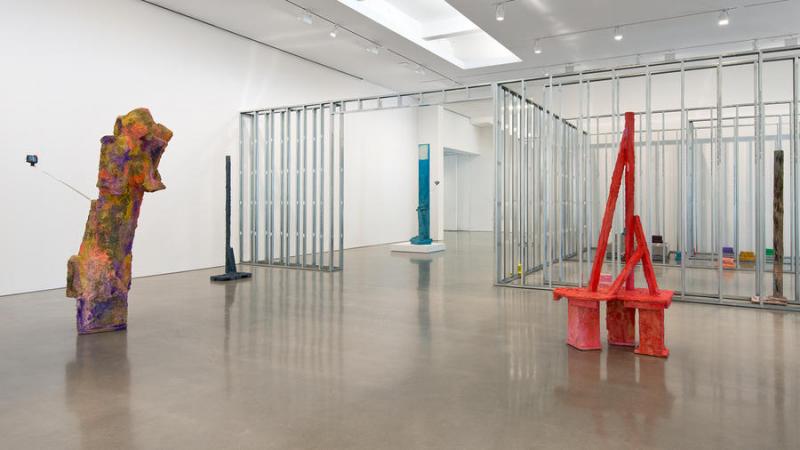What Effect Does #FOMO Have On Our Art?

But are we really gaining any genuine insight into our friends’ lives? Or are we just torturing ourselves by living in a constant state of FOMO? More importantly, is what we are posting an actual representation of what is going on in our lives and what we are experiencing? Or we are just mindlessly posting in order to please our virtual followers?
READ MORE: 9 Artsy AF Shows, Exhibits and Events You Have To Check Out This July
Mixed media artist Rachel Harrison’s show “Three Young Framers,” which just wrapped at the Regen Projects gallery in L.A., explores how #FOMO influences our view on self-representation, the consequences of interacting so intimately with social media on a regular basis, and to what extent social media has the ability to influence our personal taste and the places we actively choose to spend our time. “Three Young Framers” leaves viewers contemplating whether as a society, we are more interested in actually experiencing art and visiting an art exhibit, or if we have become so consumed with “sharing” our experience via social media that we fail to fully experience the art itself.
Harrison's show meditates on un-inventiveness throughout the various sculptural installations, drawings and photographs. The 34 images made on an iPhone, titled “FOMO,” showcase nothing particularly interesting; they highlight the detrimental combination of desperation and self-importance.
READ MORE: Say What? How Emoji Are Changing The Way We Communicate
The exhibit focuses on two central themes: the recording of our personal actions and appearance, and the presentation of artwork within the context of exhibition. Through metal-studded labyrinths and cement-slathered architecture, viewers are encouraged to explore the space by making their way, slipping and sliding, about the exhibition through these spaces. Harrison questions the relationship between the artistic experiences we are crafting via social media and how they impacts the way we interact with real art in real time; has social media created a duller art viewing experience?
Social media might be affecting the way we interact with art more than we would like to admit. Maybe we are so obsessed with the execution of the art via social media that we have yet to truly experience the art itself. This could lead to a shallower relationship with the art, as the way we are viewing art, currently, might be fueled less by art and more by social media sharing.
Another section of the exhibit focuses on “borrowed vividness,” with little originality from Harrison. However, this “borrowed vividness,” obtained from John McPhee, is purposefully crafted in order to question if what we are creating and posting on social media is an honest reflection of our original selves or we're presenting a "borrowed" view.
Harrison’s overall approach towards art and social media is unique; it is as if her entire exhibit serves as a wake-up call to society, as she seems to be mocking our obsession with social media and the two-dimensional, dull, effect some might say it has on people’s relationship with art.
Harrison’s joking tone is exposed both verbally and visually. For example, the sculpture "Magnum" contains a sack of lead tucked into its base, which alludes to shooting with both a camera and a gun, but without any synergistic payoff, a nod to the absurd degree of seriousness people assign to social media.
Social media is meant to be fun; it’s not meant to cause anxiety, stress or competition, but unfortunately, social media has proven to cause all three. Caterina Fake, co-founder of Flickr, the photo-sharing service, and of Hunch, a recommendation engine, said, “Social software is both the creator and the cure of FOMO,” adding, “It’s cyclical.”
“When we scroll through pictures and status updates, the worry that tugs at the corners of our minds is set off by the fear of regret," says Dan Ariely, author of “Predictably Irrational” and a professor of psychology and behavioral economics at Duke University. He says we become afraid that we’ve made the wrong decision about how to spend our time.
And the saddest part of all of this is that a lot of people are dismissive of the influence social media has on our lives. According to the Huffington Post, the less people felt autonomy, competence and connectedness in their daily lives, the more they felt FOMO. Even more frightening, Przybylski said, was that students reporting high levels of FOMO were more likely to admit to distracted driving habits, including texting or emailing while driving. Fear of missing out likely has to do with people's ability to self-regulate and focus on the moment.
As a society, our entire mindset needs a makeover; we must abandon our obsession with social media and “fear of missing out” in order to, quite frankly, not miss out on the the experience of living. Instead, we must be present in the moment. In the Buddhist tradition, it is believed that “mindfulness,” a mental state achieved by focusing one's awareness on the present moment, can help relieve us from our suffering. When practicing mindfulness, one must not focus on the past or the future but instead center their energies on their present thoughts, feelings and emotions he or she is experiencing at that moment. Mindfulness helps us connect to the truth of reality, as one becomes cognizant of what is actually happening in actuality. Now, more than ever, in order to hone into the beauty of existence, we must acknowledge the world around us and practice mindfulness throughout our daily lives in order to escape the suffering and disconnect with reality that #FOMO and social media have proven to cause.
If you are interested in learning more about mindful meditation, check it out here.
Contact Staff Reporter Natalie Raphael here.



